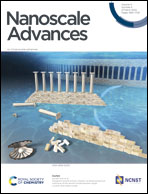Moderate molecular recognitions on ZnO m-plane and their selective capture/release of bio-related phosphoric acids†
Abstract
Herein, we explore the hidden molecular recognition abilities of ZnO nanowires uniformly grown on the inner surface of an open tubular fused silica capillary via liquid chromatography. Chromatographic evaluation revealed that ZnO nanowires showed a stronger intermolecular interaction with phenylphosphoric acid than any other monosubstituted benzene. Furthermore, ZnO nanowires specifically recognized the phosphate groups present in nucleotides even in the aqueous mobile phase, and the intermolecular interaction increased with the number of phosphate groups. This discrimination of phosphate groups in nucleotides was unique to the rich (10![[1 with combining macron]](https://www.rsc.org/images/entities/char_0031_0304.gif) 0) m-plane of ZnO nanowires with a moderate hydrophilicity and negative charge. The discrimination could be evidenced by the changes in the infrared bands of the phosphate groups on nucleotides on ZnO nanowires. Finally, as an application of the molecular recognition, nucleotides were separated by the number of phosphate groups, utilizing optimized gradient elution on ZnO nanowire column. Thus, the present results elucidate the unique and versatile molecular selectivity of well-known ZnO nanostructures for the capture and separation of biomolecules.
0) m-plane of ZnO nanowires with a moderate hydrophilicity and negative charge. The discrimination could be evidenced by the changes in the infrared bands of the phosphate groups on nucleotides on ZnO nanowires. Finally, as an application of the molecular recognition, nucleotides were separated by the number of phosphate groups, utilizing optimized gradient elution on ZnO nanowire column. Thus, the present results elucidate the unique and versatile molecular selectivity of well-known ZnO nanostructures for the capture and separation of biomolecules.



 Please wait while we load your content...
Please wait while we load your content...